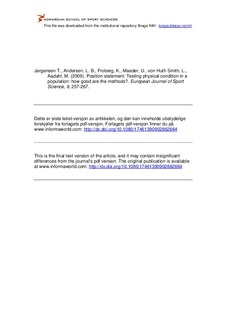| dc.contributor.author | Jørgensen, Torben | |
| dc.contributor.author | Andersen, Lars Bo | |
| dc.contributor.author | Froberg, Karsten | |
| dc.contributor.author | Maeder, Urs | |
| dc.contributor.author | von Huth Smith, Lisa | |
| dc.contributor.author | Aadahl, Mette | |
| dc.date.accessioned | 2010-11-01T14:17:52Z | |
| dc.date.available | 2010-11-01T14:17:52Z | |
| dc.date.issued | 2009-09 | |
| dc.identifier | Seksjon for idrettsmedisinske fag / Department of Sports Medicine | |
| dc.identifier.citation | European Journal of Sport Science. 2009, 9(5), 257-267. | en_US |
| dc.identifier.issn | 1746-1391 | |
| dc.identifier.uri | http://hdl.handle.net/11250/170797 | |
| dc.description | I Brage finner du siste tekst-versjon av artikkelen, og den kan inneholde ubetydelige forskjeller fra forlagets pdf-versjon. Forlagets pdf-versjon finner du på www.informaworld.com: http://dx.doi.org/10.1080/17461390902862664 / In Brage you'll find the final text version of the article, and it may contain insignificant differences from the journal's pdf version. The original publication is available at www.informaworld.com: http://dx.doi.org/10.1080/17461390902862664 | en_US |
| dc.description.abstract | A poor physical condition - expressed as physical inactivity and poor physical fitness - is associated with the development of chronic diseases and premature death. Our aim was to evaluate the methods currently available for measuring physical activity and physical fitness in the general population.
Physical activity is determined by duration, frequency, and intensity and derives from many different domains, making it difficult to assess over long periods and no feasible general criterion measure exists. Both objective and subjective methods are available. Of the objective methods, accelerometry is the most attractive technology, and is well enough developed for general use in large populations. The advantage of accelerometry is that it is not dependent on the memory of the individual, but its main disadvantage is that it grossly underestimates energy expenditure, due to the lack of registration of certain activities. This may be overcome to a certain extent by combining accelerometry with heart rate monitoring, although this still does not measure activity in different domains. Of the subjective methods, self-report questionnaires are inexpensive and easy to administer. Many questionnaires have been developed, but we require (1) consensus on which measures to use for validation and (2) further development of internationally standardized questionnaires for use in different settings and to address different scientific questions. Many questionnaires correlate well with biological markers and development of chronic diseases, but subjective measurement will always entail a certain degree of misclassification. Furthermore, unstructured physical activity such as housework and gardening may be subject to recall bias. No method appears better to any other, and the choice of instrument will depend on the research question being asked. Future research should combine information from both objective and subjective methods.
Physical fitness comprises several components, including cardiorespiratory endurance and muscle strength and endurance. Direct measurement of oxygen consumption is the criterion measure for cardiorespiratory endurance. As regards muscle strength and endurance, only test-retest reliability is available. Hand-held dynamometers greatly facilitate field testing for maximal isometric muscle strength assessment, while force plate measurements can be used for the lower extremities. For endurance, simple tests such as push-ups and sit-ups are reliable. | en_US |
| dc.language.iso | eng | en_US |
| dc.publisher | Taylor and Francis | en_US |
| dc.subject | physical activity | en_US |
| dc.subject | physical fitness | en_US |
| dc.subject | epidemiology | en_US |
| dc.title | Position statement: Testing physical condition in a population: how good are the methods? | en_US |
| dc.type | Journal article | en_US |
| dc.type | Peer reviewed | en_US |
| dc.subject.nsi | VDP::Social science: 200::Social science in sports: 330::Other subjects within physical education: 339 | en_US |
| dc.source.pagenumber | 257-267 | en_US |
